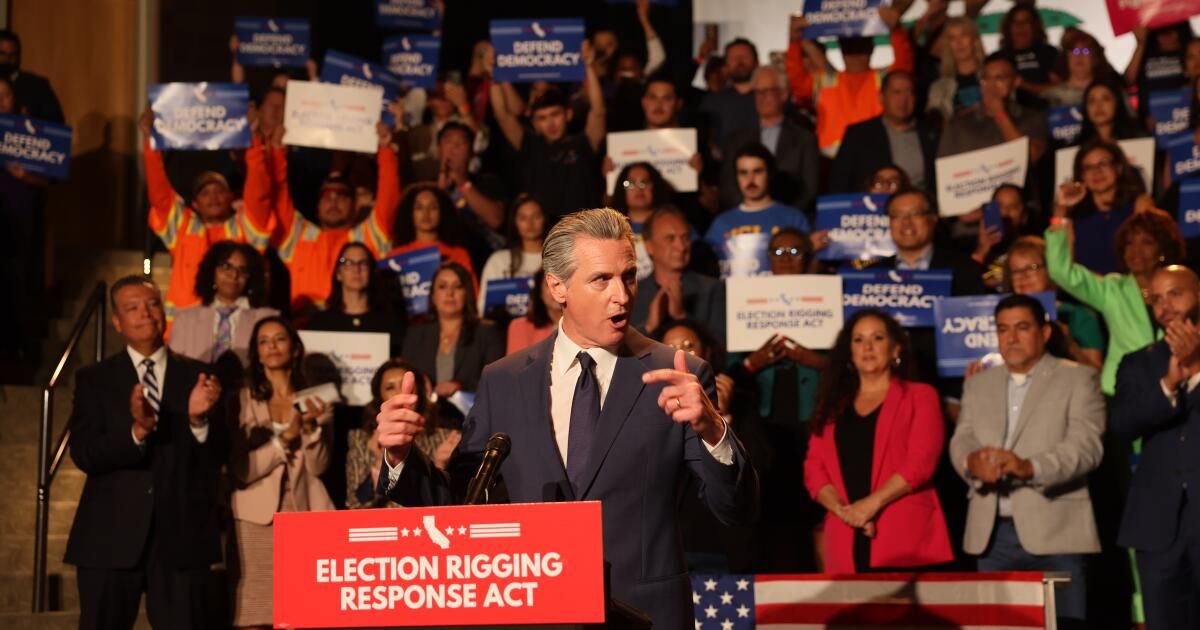A decade and a half after California voters stripped the legislators of the ability to attract the limits of the congress districts, Governor Gavin Newsom and the companions of Democrats are pressing to recover that partisan power.
The Distriction Redistribution Plan that takes shape in Sacramento and headed towards the voters in November could change the political landscape of the Golden State for at least six years, if not more, and influence the part of the United States representatives' part of the United States representatives after the medium -term elections of 2026, which will be fundamental for the fate of the political agenda of President Trump.
What Golden State voters choose to reverberate throughout the country, will kill some political careers and launching others, causing other states to reconfigure their own congress districts and boost Newsom profile as a Nemesis of Trump and leader of the nation's democratic resistance.
The new maps, drawn by democratic strategists and legislators behind closed doors, were submitted to legislative leaders by the campaign committee of the Democratic Congress on Friday. They are expected to appear on a special electoral ballot on November 4, together with a constitutional amendment that would annul the Independent District Redistribution Commission approved by the voters of the State.
The changes would extend through hundreds of Miles from California, from the forests near the Oregon state line through the deserts of the Valley of Death and the springs of Palm to the border between the United States and Mexico, expanding the control of the Democrats on California and isolation to the Republicans.
The proposed map would concentrate the Republican voters in a handful of deep red districts and eliminate a seat in the Inner Empire Congress represented by the oldest member of the Republican Delegation of California. For the Democrats, the plans would increase the fortune of promising politicians and underpin vulnerable headlines in Congress, including two new legislators who won elections in less than 1,000 votes last fall.
“This is the final statement of political war between California and the Trump administration,” said Thad Kousser, a professor of Political Science at UC San Diego.
How will the vote work?
In order for the State to revert the independent districts redistribution process that the electorate approved in 2010, the majority of California voters would have to approve the measure, that the sponsors are calling the “Law of Response to Rigging Election”.
The State Legislature, where the Democrats have a supermay in both the assembly and in the Senate, will consider the voting language next week when legislators return from the summer break. Both cameras would need to approve the vote language by a two -thirds majority and obtain the bill to the Newsom desktop before August 22, leaving enough time for voter guides to be sent by mail and print the tickets.
The vote language has not been released. But the decision to approve the new map would finally be at the height of the state electorate, which supported the redistribution of independent districts in 2010 in more than 61%. Registered Democrats exceed in number to Republican voters by almost a margin of two to one in California, providing a determined advantage for supporters of the measure.
Newsom has said that the measure would include a “trigger”, which means that the state maps would only enter into force if a republican state, including Texas, Florida and Indiana, approves the new medium decade maps.
“There is still an exit ramp,” said Newsom. “We hope that they will not continue.”
Explain the esoteric concept of redistribution of districts and get voters to participate in an out of the year will require that Newsom and its allies, including organized work, launch what is expected to be a very quickly expensive campaign.
“It's summer in California,” Kousser said. “People are not focused on this.”
California has no limit on campaign contributions for voting measures, and a measure that faces Democrats against Trump and Republicans against Newsom, could become a national high -risk and high -cost national fight.
“They are tens of millions of dollars, and it will be determined on the basis of how an opposition looks,” said Newsom on Thursday. The fundraising effort, he said, “is not insignificant … taking into account the 90 -day sprint.”
The website of the Bulleton measurement campaign mentions three main sources of financing so far: the Newsom governor campaign, the main political action committee for the Democrats of the House of Representatives in Washington and the businessman of Manhattan Beach, Bill Bloomfield, a donor for a long time to the Democrats of California.
It is also expected that those who oppose the redistribution of districts in the mid -decade are well financed, and will argue that this effort betrays the will of the voters who approved the redistribution of districts of the Independent Congress in 2010.
What is at stake?
The control of the United States Representatives Chamber hangs in balance.
The match that holds the White House tends to lose house seats during the mid -period elections. Republicans have a thin majority in the camera, and the Democrats who take control of the camera in 2026 would hinder the controversial right -wing agenda of Trump in their last two years in office.
The redistribution of districts usually only occurs once a decade, after the census of the United States. But Trump has been promoting Republican states, starting with Texas, to re -draw their lines in the mid -decade to increase the possibilities of the Republican Party in half of the peoples.
To Trump's stimulus, the Governor of Texas, Greg Abbott, convened a special legislative session to re -draw the map of the Texas Congress to favor five more Republicans. In response, Newsom and other California Democrats have asked for their own maps that would favor five more Democrats.
Texas Democratic legislators fled the State to deny the legislature a quorum and stop the vote. They faced daily fines, death threats and calls to be removed from office. They agreed to return to Austin after the special session ended on Friday, with a condition that California Democrats advanced with their districts redistribution plan.
The situation has the potential to become an armed career of redistribution of districts, with Trump supported by Indiana, Florida, Ohio and Missouri to draw their maps again, while Newsom is asking for the same of the blue states, including New York and Illinois.
California Republicans in the sights
The California Gerrymandering Plan points to five of the nine Republican members of the California Congress: the representatives Kevin Kiley and Doug Lamalfa in northern California, representative David Valadao in the Central Valley and the representatives Ken Calvert and Darrell Issa in southern California.
The map consolidates Republican voters in a smaller number of ruby red districts known as “votes of votes.” Some conservative and rural areas would become districts where Republican voters would be diluted due to a high voter registration advantage for Democrats.
The greatest change would be for Calvert, who would see his district of the inner empire eliminated.
Calvert has been in Congress since 1992 and represents an expanding Riverside County district that includes Lake Elsinore, Menife, Palm Springs and its Crown Operations Base. Calvert, who supervises defense expense in the powerful Chamber Assignments Committee, comfortably won the re -election last year despite a well -financed national campaign of the Democrats.
Under the proposed map, the District of the Interior Empire would be carved and redistributed, distributed to a district represented by the representative Young Kim (R-Anheim Hills). Liberal Palm Springs would be transferred to the district represented by Representative Darrell Issa (R-Bonsall), which would help to tip the Republican district to a strictly divided swing seat.
The members of the Congress are not obliged to live in their districts, but there would be no obvious seat so that Calvert is postulated, unless he was applied against Kim or Issa.
The filtered screen captures of the map began to circulate on Friday afternoon, which caused a fierce and immediate setback from the Republicans of California.
The lines are “Third World dictator things,” said Orange County Republican president, Will O'Neill in X, and the “cut and cut of Orange County cities is obscene.”
In northern California, the limits of the Kiley district shrugged and dogleg in Sacramento suburbs to add registered democrats. Kiley said in a publication on the social media site X that he expected his district to remain the same because the voters “would defeat the simulated Newsom initiative and claim the will of California voters.”
The Lamalfa district would be changed south, far from rural and conservative areas along the Oregon border, and would collect more liberal areas in parts of Sonoma County,
In the center of California, the limits would change to the representatives of Earth Josh Harder (D-Tracy) and Adam Gray (D-Merced). Gray won the elections last year for 187 votes, the closest margin in the country.
Valadao, a perennial objective for the Democrats, would see that the northern limit of its district extends to the most blue suburbs in Fresno. Democrats have tried for years to disassemble Valadao, who represents a district that has a strong record of registration of Democratic voters in paper, but where participation between blue voters is mediocre.
Seats of Open Eyes Democrats
Maps include a new seat in Congress in Los Angeles County that would extend in the cities of Southeast Downey, Santa Fe Springs, Whittier and Lakewood. An open seat in Congress is a rare opportunity for politicians, especially in Blue de Los Angeles County, where titular legislators can keep their work for decades.
Parts of that district were once represented by the American representative withdrawn Lucille Roybal-ralard, the first Mexico American woman chosen for Congress. That position was eliminated in the Redistribution of Districts of 2021, when California lost a seat in Congress for the first time in its history.
The Los Angeles County Supervisor, Hilda Solis, told the members of the California Congress delegation that she is thinking about running for the new seat.
Another possible contender, the former speaker of the Anthony Rendon Assembly of Lakewood, launched a campaign for the State Superintendent of Schools at the end of July and may be out of the mixture.
Other legislators representing the area or nearby areas include state senator Blanca Rubio (D-Baldwin Park), state senator Bob Archuleta (D-Pico Rivera) and state assemblyman Lisa Calderón (D-Whittier).
In northern California, the southern end of the Lamalfa district would be extended south in the cities of Sonoma County of Santa Rosa and Healdsberg, home of the Pro Tem Mike McGuare of the Senate. McGuare will be fired from the state Senate next year, and the new seat could present an opportunity in the first place to go to Washington.












